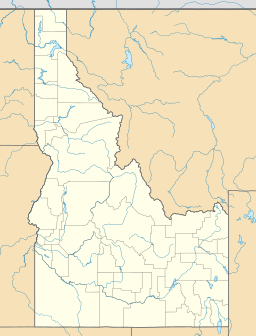Snowbank Lake (Idaho) facts for kids
Quick facts for kids Snowbank Lake |
|
|---|---|
| Location | Elmore County, Idaho |
| Coordinates | 43°56′49″N 115°07′20″W / 43.947075°N 115.122292°W |
| Type | Glacial |
| Primary outflows | Johnson Creek to Middle Fork Boise River |
| Basin countries | United States |
| Max. length | 0.10 mi (0.16 km) |
| Max. width | 0.07 mi (0.11 km) |
| Surface elevation | 8,875 ft (2,705 m) |
Snowbank Lake is a beautiful, small lake located high up in the mountains of Idaho, in a place called Elmore County. It's known as an alpine lake because it sits in a very high area, surrounded by tall peaks. This lake was formed a long, long time ago by glaciers, which were giant sheets of ice moving across the land.
Contents
Discovering Snowbank Lake
Snowbank Lake is found within the amazing Sawtooth Mountains. These mountains are part of the larger Sawtooth National Recreation Area, which is a special place set aside for people to enjoy nature. The lake itself is quite small, about 0.10 miles long and 0.07 miles wide.
Where is Snowbank Lake?
This hidden gem is located in the Sawtooth Wilderness. A wilderness area is a protected natural space where human activity is limited to preserve its wild character. It's a place where you can experience nature just as it is, with very few signs of people.
Visiting the Lake
Getting to Snowbank Lake is an adventure! There aren't any direct trails that lead straight to the lake. However, some trails in the Sawtooth National Forest, like trails 458, 494, and 459, get pretty close. From there, you might need to hike off-trail to reach the lake.
Wilderness Permits
Because Snowbank Lake is inside the Sawtooth Wilderness, visitors need a special wilderness permit. You can get this permit easily at a registration box found at the start of trails or at the wilderness boundaries. These permits help keep track of visitors and protect the natural environment.
How Snowbank Lake Was Formed
Snowbank Lake is a glacial lake. This means it was created by the powerful forces of glaciers. Thousands of years ago, huge sheets of ice slowly moved through the mountains, carving out valleys and basins. When these glaciers melted, they left behind water that filled these basins, forming lakes like Snowbank Lake.
Water Flow
Water flows out of Snowbank Lake into a stream called Johnson Creek. This creek then joins the Middle Fork of the Boise River. This shows how all the water in nature is connected, flowing from high mountain lakes down to larger rivers.



